An edge is a line connecting two vertices that forms the side of a polygon. An edge can't be shared by more than two polygons. Also, the normals of the two polygons should be adjacent. If they aren't, you wind up with two edges that share vertices.
At the editable poly Edge sub-object level, you can select single and multiple edges and transform them using standard methods.
Interface
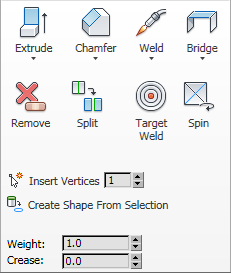
-
 Extrude
Extrude
- Lets you extrude edges manually via direct manipulation in the viewport. Click this button, and then drag vertically on any edge to extrude it.
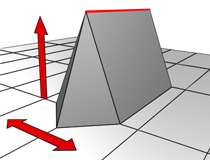
When extruding a vertex or edge interactively in the viewport, you set the extrusion height by moving the mouse vertically and the base width by moving the mouse horizontally.
Extruding an edge moves it along a normal and creates new polygons that form the sides of the extrusion, connecting the edge to the object. The extrusion has either three or four sides; three if the edge was on a border, or four if it was shared by two polygons. As you increase the length of the extrusion, the base increases in size, to the extent of the vertices adjacent to the extruded edge's endpoints.
Following are important aspects of edge extrusion:
- When over a selected edge, the mouse cursor changes to an Extrude cursor.
- Drag vertically to specify the extent of the extrusion, and horizontally to set the size of the base.
- With multiple edges selected, dragging on any one extrudes all selected edges equally.
- You can drag other edges in turn to extrude them while the Extrude button is active. Click Extrude again or right-click in the active viewport to end the operation.
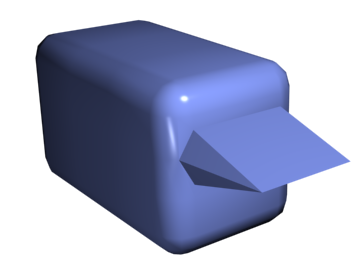
Chamfer box showing extruded edge
Note: To open the Extrude Edges dialog, choose Extrude Settings from the drop-down menu or Shift+click the Extrude button. - Extrude Settings (on Extrude drop-down)
- Opens the Extrude Edges caddy, which lets you perform extrusion via interactive manipulation.
If you click this button after performing a manual extrusion, the same extrusion is performed on the current selection as a preview and the caddy opens with Extrusion Height set to the amount of the last manual extrusion.
-
 Chamfer
Chamfer
- An edge chamfer "chops off" the selected edges, creating two or more new edges for each chamfered edge. It also creates one or more polygons connecting the new edges. The new edges are exactly <chamfer amount> distance from the original edge. New chamfer polygons are created with the material ID of one of the neighboring polygons (picked at random) and a smoothing group that is an intersection of all neighboring smoothing groups.
To use Chamfer interactively, click this button and then drag an edge in the active object. If you drag a selected edge, the chamfer applies equally to all selected edges. To chamfer edges numerically, click the Chamfer Settings button and change the Chamfer Amount value.
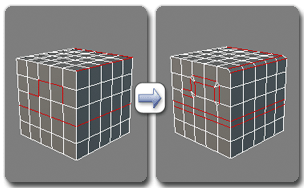
Chamfering edges
Alternatively, you can create open space between the chamfered edges; for details, see Chamfer.
Note: To open the Chamfer Edges dialog, choose Chamfer Settings from the drop-down menu or Shift+click the Chamfer button. - Chamfer Settings (on Chamfer drop-down)
- Opens the Chamfer caddy, which lets you chamfer edges via interactive manipulation and toggle the Open option.
If you click this button with one or more edges selected, the caddy opens with Chamfer Amount set to the amount of the last chamfer and the chamfer specified by the settings is performed on the current selection as a preview.
-
 Weld
Weld
- Combines selected edges that fall within the threshold specified on the Weld caddy.
You can weld only edges that have one polygon attached; that is, edges on a border. Also, you cannot perform a weld operation that would result in illegal geometry (for example, an edge shared by more than two polygons). For example, you cannot weld opposite edges on the border of a box that has a side removed.
Note: To open the Weld dialog, choose Weld Settings from the drop-down menu or Shift+click the Weld button. - Weld Settings (on Weld drop-down)
- Opens the Weld Edges caddy, which lets you specify the weld threshold.
-
 Bridge
Bridge
- Connects border edges on an object with a polygon “bridge.” Bridge connects only border edges; that is, edges that have a polygon on only one side. This tool is particularly useful when creating edge loops or profiles.
There are two ways to use Bridge in Direct Manipulation mode (that is, without opening the Bridge Edges caddy):
- Select two or more border edges on the object, and then click Bridge. This immediately creates the bridge between the pair of selected borders using the current Bridge settings, and then deactivates the Bridge button.
- If no qualifying selection exists (that is, two or more selected border edges), clicking Bridge activates the button and places you in Bridge mode. First click a border edge and then move the mouse; a rubber-band line connects the mouse cursor to the clicked edge. Click a second edge on a different border to bridge the two. This creates the bridge immediately using the current Bridge settings; the Bridge button remains active for connecting more edges. To exit Bridge mode, right-click the active viewport or click the Bridge button.
The new polygons that result from a Bridge operation are automatically selected; you can see this by accessing the Polygon sub-object level.

Using Bridge at the Edge level
Note: Bridge always creates a straight-line connection between edges. To make the bridge connection follow a contour, apply modeling tools as appropriate after creating the bridge. For example, bridge two edges, and then use Bend.Note: To open the Bridge Edges dialog, choose Bridge Settings from the drop-down menu or Shift+click the Bridge button. - Bridge Settings (on Bridge drop-down)
- Opens the Bridge Edges caddy, which lets you add polygons between pairs of edges via interactive manipulation.
-
 Remove
Remove
- Deletes selected edges and combines the polygons that use them. Keyboard equivalent:
Backspace.
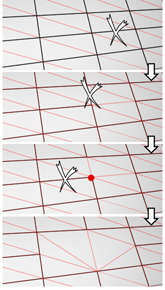
Removing one edge is like making it invisible. The mesh is affected only when all or all but one of the edges depending on one vertex are removed. At that point, the vertex itself is deleted and the surface is retriangulated.
To delete the associated vertices when you remove edges, press and hold down Ctrl while executing a Remove operation. This option, called Clean Remove, ensures that the remaining polygons are planar.

Left: The original edge selection
Center: Standard Remove operation leaves extra vertices.
Right: Clean Remove with Ctrl+Remove deletes the extra vertices.
Edges with the same polygon on both sides usually can't be removed.
Warning: Use of Remove can result in mesh shape changes and non-planar polygons. -
 Split
Split
- Divides the mesh along the selected edges.
This does nothing when applied to a single edge in the middle of a mesh. The vertices at the end of affected edges must be separable in order for this option to work. For example, it would work on a single edge that intersects an existing border, since the border vertex can be split in two. Additionally, two adjacent edges could be split in the middle of a grid or sphere, since the shared vertex can be split.
-
 Target Weld
Target Weld
- Allows you to select an edge and weld it to a target edge. When positioned over an edge, the cursor changes to a + cursor. Click and move the mouse and a dashed line appears from the vertex with an arrow cursor at the other end of the line. Position the cursor over another edge and when the + cursor appears again, click the mouse. The first edge is moved to the position of the second, and the two are welded.
You can weld only edges that have one polygon attached; that is, edges on a border. Also, you cannot perform a weld operation that would result in illegal geometry (e.g., an edge shared by more than two polygons). For example, you cannot weld opposite edges on the border of a box that has a side removed.
-
 Spin
Spin
-
Spins the selected edge or edges in the polygon, changing the direction.
Select one or more edges and then apply Spin to change how the edges subdivide the mesh. Normally the edge spins clockwise, but if you hold down Shift, the edges spin counterclockwise.
-
 Insert Vertices
Insert Vertices
-
Inserts vertices in selected edges.
Select edges, set the number of vertices to insert in each, and click Insert Vertices. The inserted vertices are spaced evenly along each selected edge. Also, the Vertex sub-object level is activated and the new vertices are selected.
-
 Create Shape From Selection
Create Shape From Selection
- After selecting one or more edges, click this button to create a spline shape from the selected edges. The new shape's pivot is placed at the center of the poly object. The process varies slightly depending on the poly object type:
- With an editable poly object, a Create Shape dialog appears, letting you name the shape and set the shape type to Smooth or Linear.
- With an Edit Poly object, the shape is created immediately, using the current Create Shape settings (name and shape type).
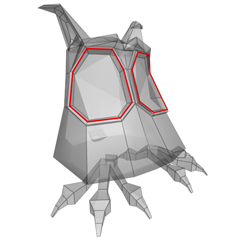
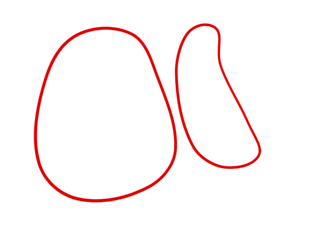
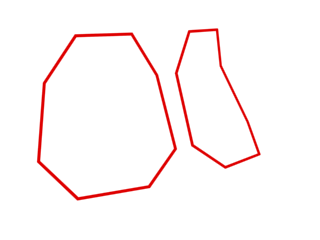
An edge selection (top); a smooth shape (center); a linear shape (bottom)
- Weight
- Sets the weight of selected edges. Used by the
NURMS subdivision option and by the
MeshSmooth modifier.
Increasing an edge weight tends to push the smoothed result away.
Note: When the Select And Manipulate tool is active at the Edge sub-object level, the caddy appears in the viewport with a control for edge weight: .
.
For instructions for using the caddy, see The Caddy Interface.
- Add Edge Weight to Caddy Manipulator (on Weight drop-down)
-
Toggles the availability of the Weight control on the The Caddy Interface when Select And Manipulate is active.
- Crease
- Specifies the extent of creasing on the selected edge or edges. Used by the
OpenSubdiv and
CreaseSet modifiers, the
NURMS subdivision option, and the
MeshSmooth modifier.
At low settings, the edge is relatively smooth. At higher settings, the crease becomes increasingly visible. At 1.0, the highest setting, the edge becomes a hard crease.
Note: When the Select And Manipulate tool is active at the Edge sub-object level, the caddy appears in the viewport with a control for edge crease: .
.
For instructions for using the caddy, see The Caddy Interface.
- Add Edge Crease to Caddy Manipulator (on Crease drop-down)
-
Toggles the availability of the Crease control on the The Caddy Interface when Select And Manipulate is active.